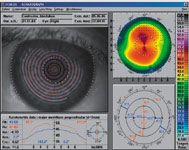Article
CK may be useful for pseudophakic astigmatism
Author(s):
London-Conductive keratoplasty (CK, Refractec), an effective treatment for the correction of hyperopia or presbyopia, might be a useful procedure for cataract patients with residual astigmatism, according to Tejas D. Shah, MD, who spoke at the XXIV Congress of the European Society of Cataract and Refractive Surgeons.

Dr. Shah, founder and chief executive officer of Amdavad Eye Laser Hospitals, Ahmedabad, India, described his prospective study of 25 pseudophakic eyes with residual astigmatism that ranged from 2 to 4.25 D (mean, 3.4 D) with a goal of steepening only the flat axis of the cornea to correct the problem. All the eyes had undergone cataract surgery at least 1 year before and had to have stable refractions for at least 6 months. The only corneal surgery that patients had before the CK procedure was the cataract incision.
Treatment of residual astigmatism was conservative to avoid overcorrection, explained Dr. Shah. After the astigmatism was identified in the minus cylinder or flat axis, two treatment spots were applied to the two ends of the flat axis based on corneal topography. The treatment spots were placed at 7 mm from the entrance pupil to establish a nomogram, he said.
Treatment regimen
Treatment spots placed at 7 mm from the entrance pupil were chosen based on previous experience with CK, he said.

"When determining how much treatment to give a patient, one of the guidelines for CK is that the further away from the center of the pupil the treatment is placed, the less the effect of the treatment," Dr. Shah said. "Understandably, the closer toward the center of the pupil that the treatment is placed, the greater the effect."
He therefore surmised that treating at 8 mm instead of 7 mm from the entrance pupil might result in a less effective treatment and the need for re-treatments.
"By choosing 7 mm, we can easily titrate our nomogram by changing to either the 6-mm or 8-mm ring from the entrance pupil," he said.
Of the 25 pseudophakic eyes, six eyes had –4 D of residual astigmatism, four had –3.5 D of astigmatism, another four had –3 D of astigmatism, three had –2.5 or –2 D of astigmatism, and two fell into the –4.25 D range. After treatment with CK, a mean reduction of 1.76 D (range of 1.48 to 2.35 D) was achieved with up to 3 months of follow-up.




